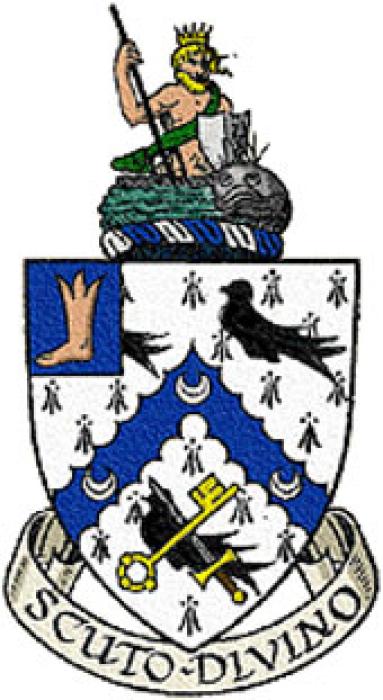Students will learn the story of young Brook Watson who lost his leg to a shark attack. By re-enacting the stances and feelings of his rescuers, they will come up with a list of adjectives to create a class definition of a hero/heroine. Then, they will create their own crest with personal symbols using Watson’s coat of arms as their inspiration.

Language
Materials
- Large sheet of paper or board to write adjectives to develop a definition of hero/heroine
- Drawing materials
- Copies of the “Design Your Own Coat of Arms” template
- Computers with internet access for student research (if they wish to come up with a Latin motto)
Warm-Up Questions
What is going on in the painting? What do you think happened just before this moment?
Background
In 1749, fourteen-year-old Brook Watson, a young English cabin boy, was attacked by a shark while swimming in the harbor at Havana, Cuba. Nine sailors rushed to help the boy and saved him from almost certain death, though he lost his right leg to the knee.
Watson grew up to be an important merchant and, briefly, Lord Mayor of London. He did not want his story of danger, courage, and survival to be forgotten. He asked John Singleton Copley, an American artist working in London, to paint this picture as a record of the events. Copley, America’s most important colonial painter, had traveled to Europe in 1774 to study art in Rome and other cities. To escape the hostilities of the American Revolution and for artistic reasons, he and his family settled permanently in England. During his stay in London, he received many painting commissions, including this one from Brook Watson.
Watson and the Shark created a sensation when it was exhibited, in part because the subject was so grisly. To lend believability to the scene Copley, who had never visited the Caribbean, consulted maps and prints of Cuba. It’s unlikely that he painted the shark from life or from prints because he erroneously painted an ear on the beast. On the frame of the painting an inscription relates the story and states Watson’s wish that this painting “might serve a most useful lesson to youth” about the risks of foolish behavior.
Guided Practice
- How has Copley told you that Brook Watson has already suffered one attack from the shark at the moment this scene was painted? (A bloody stump below his right knee indicates that the shark has bitten off his lower leg.) The shark is swimming around the boat again in the direction of Watson. Why do you think Copley chose this moment of the story to depict? (Because it is the most dramatic and suspenseful moment of the story.)
- What are the various sailors doing to try to save Brook Watson? Have nine classmates stand together and recreate their poses. Touch each student on the shoulder and ask them what they are thinking and feeling.
- How would you describe the mood of the painting? What might Watson be thinking?
- What are some character traits that these everyday heroes/heroines possess?
- Was there a time when either you or someone you know was saved or helped by a friend? What happened? How did those involved feel? What were the character traits that the hero/heroine possessed?
Activity
Students will develop a class definition of a hero/heroine:
- Ask students to write the names of four or five of their personal heroes/heroines.
- Next to each person, they will write adjectives that describe them (these may include characteristics such as strength, skill, bravery).
- Ask for volunteers to read their lists as you write the names of their heroes/heroines in one column on the blackboard and the adjectives in a second column.
- Then, in a third column, ask students to help you categorize each hero/heroine—sports, military, everyday, etc. Use the adjectives and categories from the second and third columns to help students develop a class definition of hero/heroine.
Extension

Brook Watson’s Crest
Throughout his life, Watson enjoyed telling stories of his horrible encounter with the shark. When he became a baronet in 1803, he even requested that his coat of arms include literal references to the ordeal. The Latin motto Scuto Divino means "under God's protection." Neptune, god of the sea, is shown at the top, holding a trident to repel the attacking shark, and in the upper left corner of the shield is Watson's missing foot.
Taking cues from Watson’s crest, have students write/sketch a list of symbols that represent their lives: hobbies, personality traits, pets, life events, or perhaps they too have overcome an obstacle like Watson. With their writing and sketching as their guide, students will create a coat of arms incorporating these personal symbols. Using the “Design Your Own Coat of Arms” template, students can choose to have four symbols separated into quadrants or combine them into a cohesive design. They may wish to cut out their sketches and rearrange them to get the best composition before drawing their final coat of arms. Lastly, they should enter a personal motto in the banner at the bottom (maybe even research one in Latin!)
National Core Arts Standards
VA:Cn11.1.5 Identify how art is used to inform or change beliefs, values, or behaviors of an individual or society.
VA:Cr1.1.5 Combine ideas to generate an innovative idea for art-making.
VA:Cr2.3.5 Identify, describe, and visually document places and/or objects of personal significance.
VA:Re7.1.5 Compare one's own interpretation of a work of art with the interpretation of others.
VA:Re7.2.6 Analyze ways that visual components and cultural associations suggested by images influence ideas, emotions, and actions.
VA:Re8.1.5 Interpret art by analyzing characteristics of form and structure, contextual information, subject matter, visual elements, and use of media to identify ideas and mood conveyed.





